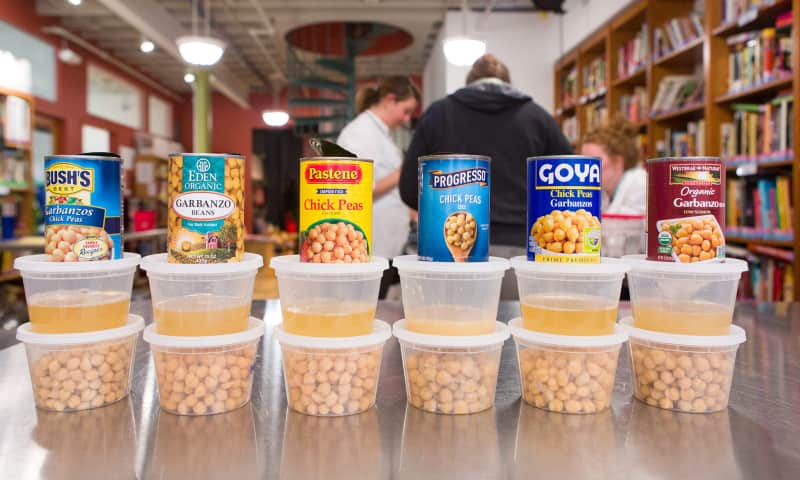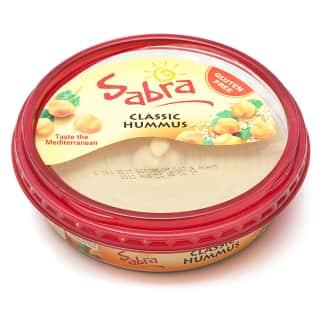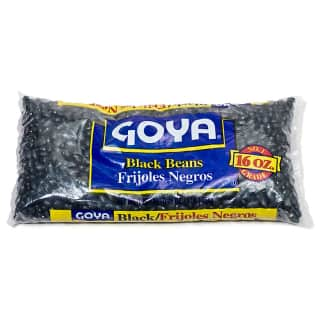If you don’t already consider chickpeas (also called garbanzo beans) a pantry staple, you should. They’re incredibly versatile, as at home in Italian pasta dishes and vegetable soups as they are in Indian curries and Middle Eastern hummus. We use them plain or crisp them on the stovetop with oil and salt to add crunch to salads and snacks. A few years ago, we started using the starchy bean liquid, called aquafaba (which we had previously poured down the sink), to add flavor and body to chickpea soups and stews. More recently, that liquid has gained traction as a vegan egg replacement in foods that don’t contain any chickpeas at all, such as meringues and muffins (see “Using Aquafaba for Egg-Free Meringues”). Now that we’re using chickpeas more frequently and in more varied applications, we thought they deserved a closer look.

Although we like dried chickpeas, we focused our attention on canned products because they’re widely available and don’t require hours of soaking and cooking. We’ve also found in past tests that the quality of canned beans can be quite good. We purchased six products, all nationally available, in 14- to 16-ounce cans. We started by tasting them plain and pureed into homemade hummus; in these tests, we first drained and rinsed the chickpeas and patted them dry. Then, to evaluate how the chickpeas fared when heated and to see if the bean liquids affected the consistency of finished recipes, we simmered the entire contents of two cans of each product in our Pasta e Ceci. At each tasting, our panel evaluated the chickpeas’ flavor, texture, and overall appeal.
The Role of Salt
It’s no secret that salt adds flavor. Two of the products had fairly low sodium levels—just 30 and 125 milligrams per ½-cup serving, which includes the bean liquid. One of these eschews salt for kombu seaweed, which the manufacturer said enhances the flavor of the chickpeas and softens them. Both products had a hint of “nutty,” slightly “sweet” chickpea flavor. But these “mild” chickpeas were easily overwhelmed by other ingredients. We can certainly add extra salt to hummus, but it’s trickier to season the actual chickpeas. In pasta, even after simmering with pancetta and aromatics, the lowest-sodium chickpeas still tasted “bland.”
Four products with much higher sodium levels, between 280 and 470 milligrams per ½ cup, were far more flavorful. In each application, higher levels of sodium enhanced the chickpeas’ natural flavors. In addition to the sweet, nutty flavors tasters noticed in the lower-sodium products, these saltier chickpeas tasted pleasantly “vegetal” and even “grassy.” Even the hummus had “strong chickpea flavor.” The top scorer fell in the middle of the salt range, with 360 milligrams of sodium per serving, but none tasted too salty.

The Perfect Chickpea Texture
We also noticed textural differences. They were most apparent in the plain tasting, but they persisted in all evaluations. Chickpeas that were soft or even “mushy” when served plain and in pasta produced hummus that was “supersmooth” but “thin.” Meanwhile, “crunchy” chickpeas produced hummus with a “gritty” quality. These chickpeas earned passable scores, but they weren’t our favorites. Tasters preferred products that were both “firm” and “tender,” with “creamy” interiors. In pasta, top scorers held their shape and remained nicely “al dente.” Hummus made with them was “thick,” “buttery,” and even “silky.” Although the bean liquids (also called aquafaba) ranged from almost clear to downright cloudy, each product contained roughly the same volume of liquid, and they all produced pasta with appropriately brothy, silky sauce.
The differences aren’t due to the type of chickpea. According to Douglas Cook, a professor in the Department of Plant Pathology at the University of California, Davis, the majority of canned chickpeas are a seed type called kabuli. He explained that Westerners generally prefer kabuli to the other common seed type, desi, which is grown in India and Ethiopia. Kabuli chickpeas are less bitter and have thinner skins, which helps them absorb moisture during cooking and canning. As a rule, kabuli chickpeas are larger and lighter in color than desi, but they can also be bred to different sizes and other manufacturer specifications, which may explain some of the differences we observed.

How Chickpeas Are Grown and Processed
To understand other variables, we spoke with Mark Kirsten, a third-generation chickpea grower and distributor in California. He explained that virtually all canned chickpeas are first dried at the farms and then shipped to canneries, where they’re soaked, blanched, and pressure-cooked in the cans. Manufacturers often add salt and color-preserving additives or firming agents. Experts told us that these soaking and cooking steps probably created the differences we saw in our chickpeas. Firmer chickpeas were likely cooked for less time and/or at lower temperatures. Meanwhile, softer chickpeas were probably processed longer and/or at hotter temperatures. (The softest also had the thickest, most opaque bean liquid—a sign that more starch and protein had been extracted, which experts told us indicates overcooking.) The best chickpeas, which were firm yet creamy, were processed just right or had a small amount of calcium chloride, a firming agent that’s commonly added to canned beans.
Ultimately, we can fully recommend four of the six products we tasted. But one earned top marks in all three tastings. With 360 milligrams of sodium per ½ cup, Goya Chick Peas were “earthy,” slightly “nutty,” and “firm with just enough give.” Our test cooks have also gotten great results when using the aquafaba from our new winner in desserts and other recipes.
- Taste plain
- Taste pureed in hummus
- Taste in Pasta e Ceci to see how the chickpeas fare when cooked and if differences in their bean liquids affect consistency of finished dish
- Compare nutritional information on product packaging
- Contains at least 280 milligrams of sodium per ½-cup serving, for chickpeas that taste seasoned and aren’t overwhelmed by other ingredients in recipes
- Firm-tender texture so chickpeas hold their shape when served plain and simmered in recipes
- Creamy interiors












